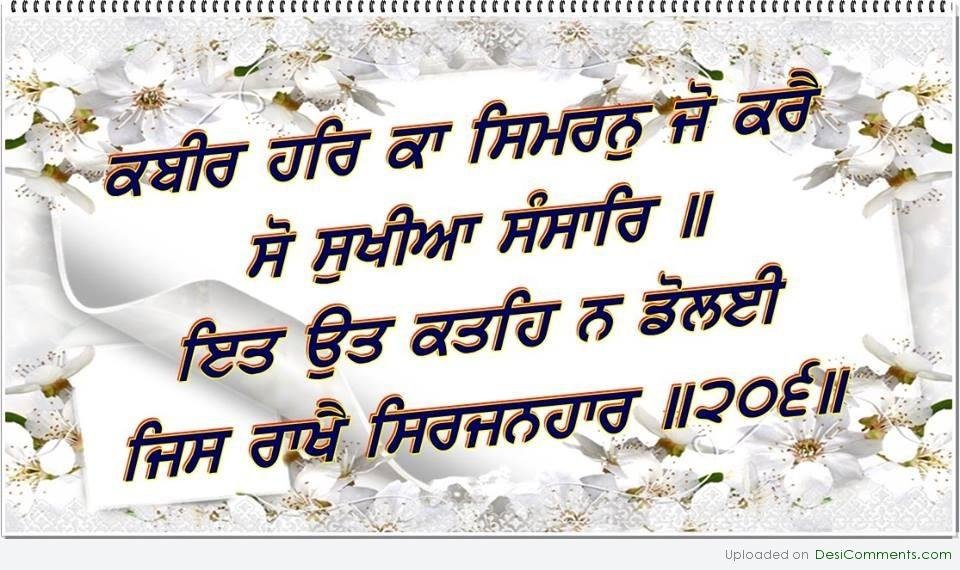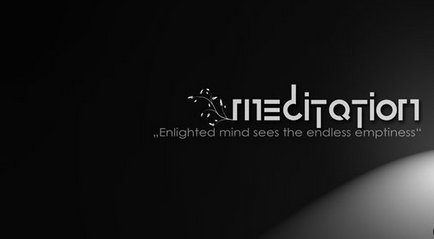|
MEDITATION, VICHAAR, SIMRAN & RELATED MATTERS |
Goings-on in cyberspace can keep one awfully occupied. On Sikh sites, the topic of meditation periodically claims its rightful place; sometimes, the discussion gets counterbalanced by Vichaar and Simran -- two defining practices of Sikhi. Generally, these two are treated as existential matters that are separate entities.
But what exactly are we talking about? Meditation is an age-old practice and is found the world over. But Sikhs seem divided about its currency in Sikh praxis. Did Guru Nanak meditate is often a question posed on the Internet; it attracts hordes of intellectual gymnastics, but admits no easy answer. Did the Gurus reject meditation and the yoga-based practices that usually accompany it? Are yoga and meditation joined at the hip in Sikhi, or is that a forced, misplaced union? What exactly is the place of each in Sikhi? And what about Vichaar and Simran? Similar questions remain about them. Let us quickly add that without a doubt, the two attributes are essential to Sikhi. What specific roles do they play in a Sikh life? What is often in question is the precise meaning of each. Are Vichaar and Simran fundamentally the same? If not, how are they different? And if we can't clearly establish the meaning of each, their practice, however construed, would remain open to tangential, varied, even conflicting interpretations. Whatever form our practice takes, it surely necessitates not only our own human striving, but also -- above all -- Guru's Grace. As Guru is "the Light of the mind," our attempts at "piercing the veil" and thus "grasping the hem of His robe" or "His Lotus Feet" (i.e., obtaining a glimpse of enlightenment), can only bear fruit when Guru's "Glance of Grace" is mercifully granted unto us. Whether these attempts are made through Vichaar, Simran, or both, no matter how intensive or persistent our efforts may be, Divine Grace remains the primordial requirement for us mortals. Grace transcends our best efforts and is never a matter of entitlement. Many major religious and secular groups speak of meditation-like practices that are usually associated with Asian societies - largely Hindu, Buddhist and Jain, but also Japanese, Chinese, and perhaps many more. Thanks to Yogi Bhajan and his worldwide mission dating from the 1960's, there is now a significant number of Sikhs, largely of non-Indian descent, that practice yoga and meditation as integral to Sikhi. Sikhs that are rooted in the India-based practice of Sikhi are often conflicted about this, or reject such mixing. The dictionary definition of meditation takes us to contemplation, musing, thinking, rumination, brooding, reverie and related activities. It could be a written or spoken discourse. Pretty universal praxis no matter where one is from, or what language, culture, or music one values. Serious aficionados of meditation will take us to Patanjali's work dating from times immemorial. When we colloquially speak of meditation today, our thought may go to the seminal work of Marcus Aurelius, dating from the year 167 or thereabouts, as well as to six meditations of René Descartes, from the mid-17th century. Often, they have a wry humor and make a catchy sound bite. We offer you one example from each. Marcus Aurelius said: "You have power over your mind, not over outside events. Realize this and you will find strength." Descartes opined: "Cogito, ergo sum." -- I think, therefore I am. There are many more by each. In a similar vein, Guru Granth reminds us that he who has disciplined his mind has conquered the world ("Munn jeetay jagjeet." Guru Granth, p. 6). We will not delve any deeper here into the old and mystic roots of meditation. A simple, perhaps simplistic, explanation of meditation is the state of deep peace that occurs when the mind is calm and silent. This implies that meditation should not and would not interfere with the daily labors of life that one is engaged in. Meditation, then, becomes a practice in which a trained mind induces a particular mode of consciousness. Obvious benefits are that the body's physiologic responses become calmer, not agitated as in a state of stress, and that the work at hand has a smoother ride. It becomes almost like a non-drug induced high, a win-win situation. Modern science clearly shows the beneficial physiological responses of such practices; further elaboration is not necessary here. And so far, this seems perfectly compatible with the message of Sikhi.
This, it seems, means living in the moment, the present, and shedding both past history and future concerns. To Sikhs, this is the ideal rendition of meditation and entirely compatible with living a life in "Hukum," as repeatedly emphasized in the Guru Granth. Theoretically at least, one is not meditating on anybody or anything in particular. However, there is mindfulness to the meditative state in action, and that's facilitated by what Sikhi dubs Simran. This has been literally translated as repetition of the Name of God. But God is best labeled as Infinite. If that is what the Creator is -- infinite -- then no matter how intensively we try, our finite language can't possibly capture the infinite reality. And that's a given. Guru Granth repeatedly tells us so; Jaap Sahib (penned by the Tenth Master Guru Gobind Singh) also repeatedly drives home the same lesson. Simran, then, becomes not endless repetition, but mindfulness; Naam dhyana is an expression that fits the same idea of simran. The root word of dhyana is dhyan, and that is literally rendered as mindfulness or to pay attention, not to mindlessly repeat something like a mantra, as is often seen in practice. Vichaar remains true to its literal meaning of critical, analytic reasoning; that liberation lies not in the simple sight of the Guru, but in a critical engagement with the Guru's Message ("Dithay mukt na hovayee jichhar sabd na karay vichaar." Guru Granth, p. 594). Also, keep in mind that a single word integrated within the self can transform the inner self ("Ek akhar har man basat Nanak hoat nihal." Guru Granth, p. 261). Simran and Vichaar thus seem to be interconnected like conjoined twins driven by a common heart. Modern meditation-masters usually mandate physical exercises (as props) involving the breath and chakras that define energy centers. Meditation happens through these media, but - and this is important -- the discipline is not the meditation, argues this rhetorical logic. The poses, exercises, closing of the eyes and breath control are not ends in themselves, nor is the oft-repeated and, at times, meaningless mantra, but self-hypnotic means to still the mind in an internally induced high. As Marshall McLuhan opined, the medium then becomes the message. The mantra could really be any string of words in an endless cycle to focus the mind. It can be useful and there's no harm in the practice, as long as we keep this in mind. It is important to realize that untold millions practice meditation, swear by it and also by the magic of the mantra. Serious practitioners of the art and science of meditation contend that the mantra is far from meaningless. Devotees of meditation tell us that yes, a meaningless chant will also increase alpha activity and elicit other physiological responses, but these are only the initial positive effects, and meditation has many more. However, an exhaustive exploration of the mechanics and the magic of meditation is not the topic today. Sikhi comes at this in a radically different manner. In Sikhi, Guru Granth - the Word - is the Eternal Living Guru. The only way to engage with words is to read them and to cogitate on them. Indeed, the method for this engagement is built intrinsically into the very essence of a Shabad, often through the vehicle of the Rahao line of a hymn, which pointedly instructs us to pause and reflect. Connecting to the Infinite through the finite human mind and language is an endless task. Reading would lead to understanding, where human effort is transformed by Grace. So says the Guru Granth repeatedly. So, the pose, the posture and the breath may seem important to some, but not to others. However, Vichaar (contemplation and analysis) leads to pivotal processes. The mind can't be isolated from the heart. The company of fellow travelers (sangat) on the same path becomes essential. They are like fellow runners on the same track in a marathon -- a life-line. We become the company we keep, says the Guru Granth ("Jo jaisee sangat milay, so taiso phal khaaye." Guru Granth, p. 1369). One can cherry-pick the Guru Granth for references to techniques of meditation that have been in fashion over time. And we offer only three examples here from the Guru Granth of the futility of specific meditative techniques: The bhagat Dhanna who is said to have assiduously meditated on a stone idol to experience God (Guru Granth, p. 487); Jaidev who speaks of breathing techniques -- one nostril for inspiration, the other for expiration (p. 1106); and finally, Guru Arjan who drives the final nail into our desperate dependency on such techniques, "Path pario er bed bichario, naval bhuangam sadhay. ...Piyaray in bidh milan naa jayee mae keeye karam aneka." (p. 641). Ergo, to us, these examples clearly appear to be descriptive of existing practices in the community of that time, and by no means prescriptive requirements. Clearly, then, Sikhi does not require a prescription of poses, exercises and breath control to still the mind. But it must prescribe some way! What is it? Sikh praxis gives us a new wrinkle on the practice that is not found, or certainly not emphasized, in traditional meditative practices that we have come across. And that is Keertan. Sikhi defines Keertan as absolutely essential to attaining the meditative state. With minor exceptions, the entire 1430 pages of Guru Granth and its several thousand hymns are composed in the Raga system of classical Indian musicology. Indian music masters and aficionados of their art have long recognized the hypnotic quality of the cadence, structure and essence of ragas and taals. When sung, they become a musical meditation. Singing a hymn that has philosophic meaning and import is exactly the meditative prescription that one needs for transforming the mind. One can easily lose oneself in the rendition of a hymn. Often, in the complex and repetitive singing where the raga enhances the impact, the meaning of the words becomes self-evident. It then no longer remains a mindless, repetitive technique. If there is yoga in Sikh praxis, we would argue that it is Keertan. Meditation can thus be thought of as both a state of mind, together with the props and practices that help us achieve a meditative state - the end and the methodology rolled into one. The confusion around meditation stems from the fact that the two terms - the goal and the technique -- are often conflated and used interchangeably. If one were to tell an Eastern spiritual master that one was trying to meditate, he or she is likely to remind us that we have it all wrong. There is nothing to do. Yet, masters prescribe props and exercises primarily for two reasons: one is that such technology comes in handy to help rein in the wandering mind; secondly, they want to reveal the folly of trying to "exert effort" in any manner, in order to reach a meditative state. In Sikhi, Keertan is the pre-eminent mode (or prop) to achieve a meditative state. Guru Granth (p. 1075) tells us, "Kaljug meh kirtan pardhana, gurmukh japiye laayeh dhyana." Music is the additional dimension that Sikhi brings to meditative practice. Without meditation, music can be merely noise; without music, meditation can become dry, arid, boring and meaningless. Apparently, the human mind is designed to resonate to Naad, or rhythm of the Shabad Guru, and different sounds and patterns elicit different responses. Observation - listening or watching - is the chief ingredient of any meditative practice. Actually, any activity, or even none, can become meditation. The idea is to be watchful and alert by paying attention, because that is where energy will follow. We experience this in everyday life: our energy follows where our attention is. Guru Nanak refers to this as "Pancha ka gur ek dhyan" (Guru Granth, p. 3). This is primarily meant to be an individual practice - part of personal hygiene, if you will. But unlike other Indian traditions, Sikh teachings regard this as a necessary condition, but not sufficient in itself. A one-sided focus on meditation - as the end in itself - can give rise to withdrawal from life and narcissistic tendencies. The real aim is to become fully engaged in the battle of life. Meditation, Simran and Vichaar are three intimately connected strands in the enchanting tapestry of a Sikh life. One could write a separate essay, if not a book on each. But that is not the goal and it would diminish a major purpose -- exploring interactions between the three. We started this exercise today to parse, in a Sikh context, the differences between Vichaar, Simran and Meditation. In fact, we seem to have seamlessly merged the three -- as they should be. The purpose remains to foster a conversation on these related practices. [email protected]; [email protected]; [email protected] August 13, 2014 |

 Musing aloud, we discovered common threads, both to our concerns and the topics; ergo, this jointly authored effort. The goal is less to provide answers etched in stone and more to open doors to pertinent queries.
Musing aloud, we discovered common threads, both to our concerns and the topics; ergo, this jointly authored effort. The goal is less to provide answers etched in stone and more to open doors to pertinent queries.  So, the word "meditation" in its classical setting speaks of musing, contemplation, etc. But meditation has had quite another dimension in the East, where it is not something you do; rather, it is a state of mind. Modern interpretation has taken on this meaning. In fact, it asks that the person drop everything, even one's memory bank, and be in a state where only awareness (consciousness) remains.
So, the word "meditation" in its classical setting speaks of musing, contemplation, etc. But meditation has had quite another dimension in the East, where it is not something you do; rather, it is a state of mind. Modern interpretation has taken on this meaning. In fact, it asks that the person drop everything, even one's memory bank, and be in a state where only awareness (consciousness) remains.